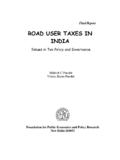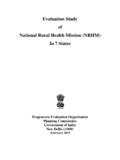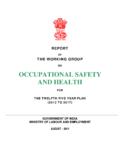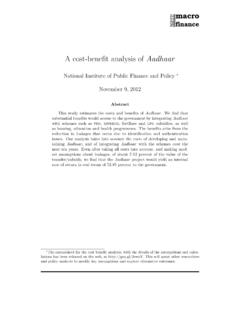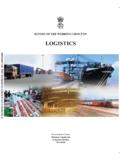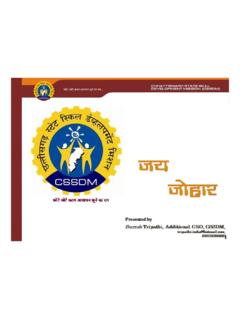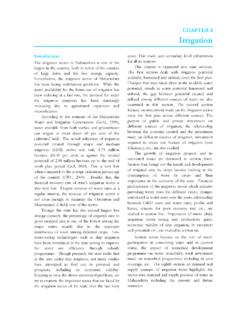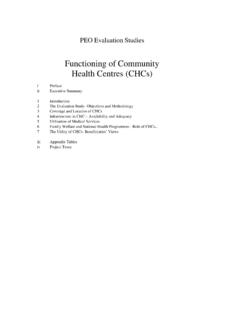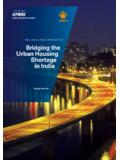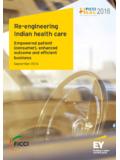Transcription of planningcommission.nic.in
1 REPORT O THESTEERING GROUP ON OREIGN DIRECT INVESTMENTP lanning CommissionGovernment of IndiaNew DelhiAugust 2002 2002 Planning Commission, New Delhi 2002 Planning Commission, New Delhi 2002 Planning Commission, New Delhi 2002 Planning Commission, New Delhi 2002 Planning Commission, New DelhiPPPPP ublished for Published for Published for Published for Published for Planning Commission blanning Commission blanning Commission blanning Commission blanning Commission by Sy Sy Sy Sy Shipra Phipra Phipra Phipra Phipra Publications, Dublications, Dublications, Dublications, Dublications, Delhielhielhielhielhie-mail: Committee Terms of Material FDI FDI FDI FDI Global India s Comparability of FDI in Direction of FDI into AND REASONS FOR LOUSES AND REASONS FOR LOUSES AND REASONS FOR LOUSES AND REASONS FOR LOUSES AND REASONS FOR LOW FDIW FDIW FDIW FDIW Image and Policy FDI Domestic Quality of State Regulatory Foreign Investment State Laws on Institutional Industry Planning and FDI Sector Fund for Assistance to Non-governmental Facilitation Raising FDI Sectoral National Culture and Natural Monopoly Natural Transition Marketing Attitude to India s Revamping Marketing Policy for Special Economic State SEZ
2 Law(s).. SEZ Infrastructure SEZ Administrative Marketing of Sector Policy Urban Infrastructure and Real De-control and Tax Rules and SUMMARUDING SUMMARUDING SUMMARUDING SUMMARUDING OREIGN DIRECT Economic Advantages of For FDI in 10th Foreign Savings and Policy Industrial Project Registration & FDI FEMA (2000).. Entry Rules & Sectoral Caps on , TRIMS and SIA & Foreign Technology Inter-Country Status of Special Economic Role of M&A and Takeover Competition Law and M& Presentations and McKinsey & A. T. Boston Consulting West Bengal and Andhra Pradesh Other Suggestions Andhra Pradesh Infrastructure 68 OREIGN DIRECT INVESTMENTA cronymsADRsAmerican Depository ReceiptsATKAT KearneyBCGB oston Consultancy GroupBOPB alance of PaymentsCADC urrent Account DeficitCCFIC abinet Committee on Foreign InvestmentCENVATC entral Value Added TaxCIIC onfederation of Indian IndustriesCPMC ritical Path MethodCrore10 millionCRRCash Reserve RatioCSTC entral Sales TaxCVDC ountervailing DutiesDCDeveloping CountriesDGFTD irector General of Foreign TradeDIPPD epartment of Industrial Policy & PromotionDTAD omestic Tariff AreaEAUE ntrepreneurial Assistance UnitEIUE conomic Intelligence UnitEOUE xport Oriented UnitsEPZsExport Promotion ZoneFDIF oreign Direct InvestmentFEMAF
3 Oreign Exchange Management ActFIASF oreign Investment Advisory ServicesFICCIF ederation of Indian Chambers of Commerce & IndustryFIIAF oreign Investment Implementation AuthorityFIIF oreign Institutional InvestorsFIPBF oreign Investment Promotion BoardFIPCF oreign Investment Promotion CouncilFPOFood Price OrderFTZsForeign Trade ZonesGDPG ross Domestic ProductGDRsGlobal Depository ReceiptsGOIG overnment of IndiaGOMG roup of MinistersIATAI nternational Air Traffic AssociationICAMTI nternational Centre for Advancement of Manufacturing TechnologyICORI ncremental Capital-Output RatioIDRAI ndustries Development & Regulation ActIEMI ndustrial Entrepreneurs MemorandumIFCI nternational Financial CorporationILDPI ndian Leather Development ProgrammeIMFI nternational Monetary FundIPAs(State) Investment Promotion AgenciesIPOI nitial Public OfferingITInformation TechnologyJBICJ apan Exim BankLNGL iquefied Natural GasM&AMergers & AcquisitionsMATM inimum Alternate TaxMESM inimum Efficient ScaleMIDAM alaysian Industrial Development AuthorityMNCM ultinational CorporationsMNEsMultinational EnterprisesMRTPM onopolies & Restrictive Trade PracticesNBFCsNon-Banking Financial CorporationsNCAERN ational Council of Applied Economic ResearchNFEENet foreign exchange earningNLDPN ational Leather Development ProgrammeNRINon-Resident IndianOCBsOverseas Corporate BodiesOECDO rganization of Economic Cooperation & DevelopmentPERTP roject Evaluation Research TechniquePMPrime MinisterRBIR eserve Bank of IndiaRCARent Control ActsRISR esearch and Information System for the Non-Aligned and
4 OtherDeveloping AsiaSouth-East AsiaSEBIS ecurities & Exchange Board of IndiaSEZS pecial Economic ZoneSIAS ecretariat for Industrial AssistanceSLRS tatutory Liquidity RatioSMEsSmall & Medium EnterprisesSSIS mall Scale IndustriesSTSales TaxTNCsTransnational CorporationsTRAIT elecom Regulatory Authority of IndiaTRIMST rade Related Investment MeasuresULCAU rban Land Ceiling ActsUNUnited NationsUNCTADU nited Nations Council for Trade and DevelopmentUNIDOU nited Nations Industrial Development OrganisationUSOU niversal Service ObligationVCCsVenture Capital MembersCommittee MembersForeign Direct Investment is one of the key variables for achieving an eightper cent growth during the Tenth Plan (2002-07). As mentioned in theApproach Paper a sharp step up in FDI is necessary for achieving the growthtargets of the Tenth Plan.
5 The Planning Commission constituted a SteeringCommittee on Foreign Direct Investment in August 2001, to achieve theseobjectives. The Steering Committee comprises of the following members:Shri Singh,ChairmanMember, Planning CommissionShri Ajit Kumar,MemberFinance Secretary, Ministry of FinanceShri V. Govindarajan,MemberSecretary (DIPP), Ministry of Commerce & IndustryShri Shashank,MemberSecretary (ER), Ministry of External AffairsDr. Reddy,MemberDeputy Governor, Reserve Bank of IndiaShri Verma,MemberChief Secretary, Government of Uttar PradeshShri Rao,MemberChief Secretary, Government of Andhra PradeshShri Manish Gupta,MemberChief Secretary, Government of West BengalShri Prodipto Ghosh,MemberAdditional Secretary, Prime Minister s OfficeShri Tarun Das,MemberDirector General, CIIDr.
6 Amit Mitra,MemberSecretary General, FICCIDr. Arvind VirmaniMember-SecretaryAdviser (DP), Planning Commission1 Preface10 10 FOREIGN DIRECT INVESTMENTMr. C. M. Vasudev, Secretary (DEA) replaced Mr. Ajit Kumar on relinquishingcharge as finance of ReferenceTerms of ReferenceThe terms of reference of the Committee were as suggest policy and governance reforms necessary for attracting privateinvestment, both domestic and identify factors which inhibit higher FDI flows and suggest examine policy reforms towards mergers and acquisition for suggest changes in institutional apparatus and organizations, both inCentre and States, for attracting the FDI suggest Policy reforms in Export Processing Zones for attractinghigher FDI suggest policy and governance reforms to attract NRIs for makinghigher examine the factors responsible for the success of other countries likeChina in attracting FDI and make suitable recommendations based onthe experience of other successful Sharat Kumar, Director, Development Policy Division, PlanningCommission assisted the Steering Group in its work.
7 Mrs. , SeniorResearch Officer, Planning Commission also provided assistance in preparingthe Direct Investment (FDI) flows are usually preferred over otherforms of external finance because they are non-debt creating, non-volatile andtheir returns depend on the performance of the projects financed by theinvestors. FDI also facilitates international trade and transfer of knowledge,skills and technology. In a world of increased competition and rapid technologicalchange, their complimentary and catalytic role can be very valuable (Appendixsection ).Foreign Direct Investment in India has constituted 1 per cent of Gross fixedcapital formation in 1993, which went up to 4 per cent in 1997. The TenthPlan approach paper postulates a GDP growth rate of 8 percent during2002-07.
8 Given the Incremental Capital-Output Ratio (ICOR) and theprojected level of domestic savings it leaves a savings gap/current accountdeficit of around per cent. This implies an increase in FDI from the presentlevels of $ billion in 2001-02 to at least around US $8 billion a year during2002-07 (Appendix section ). Steering Committee on FDI had eight meetings. In the first meetingof the Committee held on 6th September 2001 it was decided that the SteeringCommittee should come up with practical suggestions, which will help inachieving a higher levels of FDI inflow into India during the Tenth Plan. Inthe second and third meetings, leading consultancy firms and representativesfrom Chambers of Commerce were invited to make presentations of theirsurveys/analysis on FDI inflows into India (Appendix section to ).
9 The fourth meeting had presentations from the State Governments (Appendixsection ). This was followed by a presentation by Department of IndustrialPolicy and Promotion (DIPP) at the fifth meeting (Appendix section ).The sixth and seventh meeting discussed the issues connected with sectoralcaps, entry/exit barriers and other policy issues. The eighth meeting finalisedthe recommendations of the 12 FOREIGN DIRECT the consultancy groups and leading Chambers of Commerce thatmade presentations were McKinsey & Co., AT Kearney, Boston ConsultancyGroup (BCG), FICCI and CII. According to BCG most of the foreigninvestment proposals get cut off at the screening stage. They recommend arifle shot approach wherein the potential investors are short-listed and theirconcerns addressed.
10 The FICCI presentation emphasised upon the role ofarchaic legislations and labour laws, unhelpful bureaucracy etc. in causing timeand cost overruns. They suggested urgent initiatives for fast track clearanceof legal disputes and improvement in bureaucratic mind set. CII highlightedthe low levels of realization of FDI inflows vis- -vis the proposals cleared. CIIalso suggested single window clearance of FDI proposals based on the MalaysianIndustrial Development Authority (MIDA) model, for overcoming post-approval procedural delay. McKinsey & Co. divided FDI into three categories:domestic oriented, privatisation or dis-investment related and export recommended sector specific measures to improve FDI inflows. AT Kearney& Co. identified bureaucracy as the top most concern of foreign pointed to India s skilled labour force as the country s most alluring attractionfor foreign direct government of Andhra Pradesh made a presentation on its new Actrelating to Infrastructure Investment which has an inbuilt fast track government of West Bengal also made a presentation on their approachto FDI.
